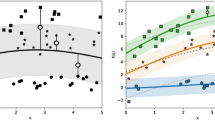Abstract
The relationship between activity level and depression in primary care outpatients was examined. Forty-eight patients with depression and 25 general medical controls wore a heart and activity level monitor for 24 h. Minute-averaged horizontal movement was collected. Patients with depression were sorted into two equal groups based on a median split of their Beck Depression Inventory-II scores. ANOVAs revealed significant main effects for average movement over the 24-h interval, average movement between 12 and 6 P.M., and a measure of “high activity” level. Patients with more severe depression had lower activity levels than the other two patient groups. The nondepressed and less severely depressed groups were combined and compared to the more severely depressed group using a standard discriminant function analysis. The overall correct classification rate was 74.0%, with 86% of the combined group and 50% of the more severely depressed group correctly classified. Patients with low activity levels were 6.0 times more likely to fall in the severely depressed group than patients with more normal activity levels.
Similar content being viewed by others
References
Aronen, E. T., Teicher, M. H., Geenens, D., Curtin, S., Glod, C. A., and Pahlavan, K. (1996). Motor activity and severity of depression in hospitalized prepubertal children. J. Am. Acad. Child Adolesc. Psychiatry 35: 752-763.
Barkley, T. J., and Tryon, W. W. (19950). Psychomotor retardation found in college students seeking counseling. Behav. Res. Ther. 33: 977-984.
Beck, A. T., Steer, R. A., and Brown, G. K. (1996). Beck Depression Inventory, 2nd ed., The Psychological Corporation, San Antonio.
Cohen, J. (1988). Statistical Power and Analysis for the Behavioral Sciences, 4th ed., Houghton Mifflin, Boston.
Futterman, C. S., and Tryon, W. W. (1994). Psychomotor retardation found in depressed outpatient women. J. Behav. Ther. Exp. Psychiatry 25: 41-48.
Gardos, G., Teicher, M. H., Lipinski, J. F., Matthews, J. D., Morrison, L., Conley, C., and Cole, J. O. (1992). Quantitative assessment of psychomotor activity in patients with neuroleptic-induced akathisia. Prog. Neuropsychopharmacol. Biol. Psychol. 16: 27-37.
Heninger, G. R., and Kirstein, L. (1977). Effects of lithium carbonate on motor activity in mania and depression. J. Nerv. Ment. Dis. 164: 168-175.
Iverson, G. L., and Thordarson, D. S. (2002). Women with low activity levels are at increased risk for depression. Ann. Behav. Med. 24(Supplement): SO83.
Joffe, R. T., Uhde, T. W., Post, R. M., and Minichiello, M. D. (1987). Motor activity in depressed patients treated with carbamazepine. Biol. Psychiatry 22: 941-946.
Kupfer, D. J., Weiss, B. L., Foster, F. G., Detre, T. P., Delgado, J., and McPartland, R. (1974). Psychomotor activity in affective states. Arch. Gen. Psychiatry 30: 765-768.
Raoux, N., Benoit, O., Dantchev, N., Denise, P., Franc, B., Allilaire, J. F., and Widlocher, D. (1994). Circadian pattern of motor activity in major depressed patients undergoing antidepressant therapy: Relationship between actigraphic measures and clinical course. Psychiatry Res. 52: 85-98.
Teicher, M. H. (1995). Actigraphy and motion analysis: New tools for psychiatry. Harvard Rev. Psychiatry 3: 18-35.
Teicher, M. H., Lawrence, J. M., Barber, N. I., Finkelstein, S. P., Lieberman, H. R., and Baldessarini, R. J. (1988). Circadian activity rhythm disturbances in geriatric major depression. Arch. Gen. Psychiatry 45: 913-917.
Wehr, T. A., Muscettola, G., and Goodwin, F. K. (1980). Urinary 3-methoxy-4-hydroxyphenylglycol circadian rhythm: Early timing (phase advance) in manic-depressives compared with normal subjects. Arch. Gen. Psychiatry 37: 257-263.
Weiss, B. L., Kupfer, D. J., Foster, F. G., and Delgado, J. (1974). Psychomotor activity, sleep, and biogenic amine metabolites in depression. Biol. Psychiatry 9: 45-54.
Wolff, E. A., Putnam, F. W., and Post, R. M. (1985). Motor activity and affective illness: The relationship of amplitude and temporal distribution to changes in affective state. Arch. Gen. Psychiatry 42: 288-294.
Author information
Authors and Affiliations
Corresponding author
Rights and permissions
About this article
Cite this article
Iverson, G.L. Objective Assessment of Psychomotor Retardation in Primary Care Patients with Depression. J Behav Med 27, 31–37 (2004). https://doi.org/10.1023/B:JOBM.0000013642.43978.f9
Issue Date:
DOI: https://doi.org/10.1023/B:JOBM.0000013642.43978.f9




